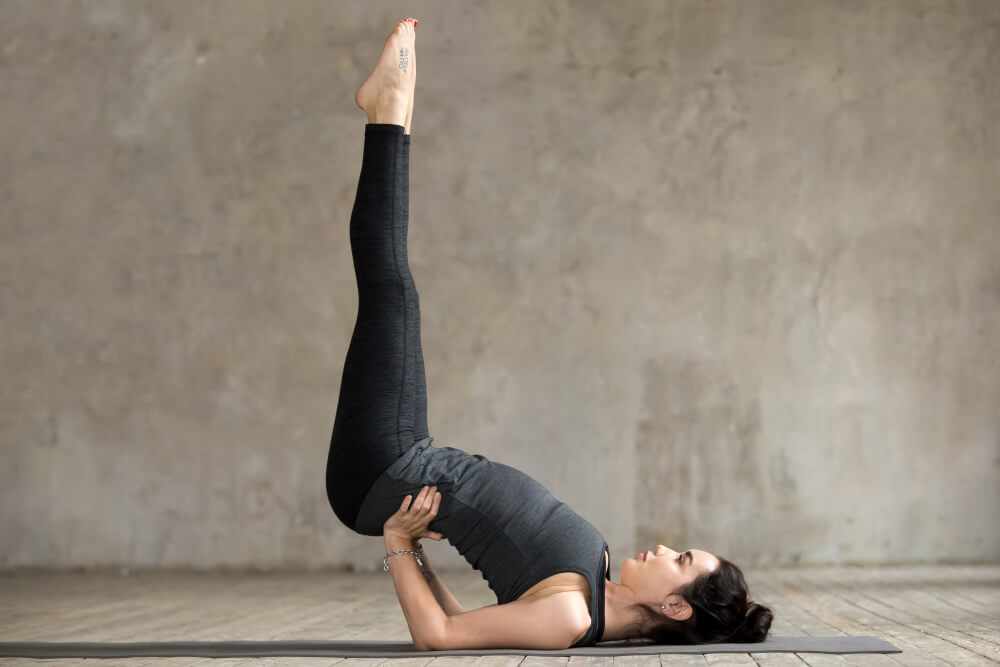
In a world marked by constant motion and busyness, finding moments of stillness and calm has become an essential pursuit for maintaining our well-being. One such refuge of tranquility lies within the practice of yoga, where a multitude of poses offers both physical and mental rejuvenation. Among these, Viparita Karani, or Legs-Up-the-Wall Pose, emerges as a beacon of restorative bliss, offering a gateway to relaxation, improved circulation, and a tranquil mind.
The Pose Unveiled
Viparita Karani, a Sanskrit term translating to “Inverted Action,” invites practitioners to lie on their backs, extending their legs vertically against a supportive wall. As the heels find their place on the wall and the body forms a right angle, a sense of surrender ensues. Palms facing upward and eyes softly closed, this pose creates a space for both physical release and mental stillness.
Steps to Practice Viparita Karani:
- Find Your Space: Begin by locating a clear wall space where you can comfortably lie down.
- Prepare Your Props: Gather a folded blanket or bolster to support your pelvis, making the pose more accessible and comfortable.
- Set the Foundation: Sit sideways next to the wall, ensuring that your hip is touching the wall. Use your hands for support as you gently lie down on your back.
- Elevate the Legs: Swing your legs up the wall, ensuring that your heels rest gently against the wall. Your sitting bones should be slightly away from the wall, and your legs should form a 90-degree angle with your torso.
- Create Comfort: If your lower back feels strained, adjust the distance between your sitting bones and the wall, or place a prop under your pelvis for added support.
- Relax and Breathe: Allow your arms to rest comfortably at your sides, palms facing up. Close your eyes and take slow, deep breaths. Focus on the sensation of your breath and the support of the wall.
- Stay Present: Remain in the pose for 5 to 15 minutes, or as long as it feels comfortable. Use this time to let go of tension, cultivate mindfulness, and enjoy the stillness.
- Release Mindfully: To exit the pose, bend your knees and roll onto one side before gently pressing yourself up to a seated position.
Benefits of Viparita Karani:
1. Enhanced Circulation: Elevating the legs above the heart level encourages venous return, aiding blood circulation. This natural “reboot” assists in reducing swelling and fatigue in the lower limbs.
2. Relaxation and Stress Reduction: Viparita Karani guides the parasympathetic nervous system to the forefront, ushering in a state of relaxation. As the mind and body unwind, stress and anxiety find their retreat, leaving a serene mental landscape in their wake.
3. Aid for Mind and Soul: This pose is not only a respite for the body but also a sanctuary for the mind. In its simplicity, Viparita Karani nurtures mindfulness, providing an opportunity to detach from the incessant stream of thoughts and simply “be.”
4. Revitalizing Fatigued Legs: For those shackled by sedentary routines or those constantly on their feet, the gentle stretch and release offered by this pose offer solace. The legs, often burdened, find reprieve and rejuvenation.
5. Assistance to Digestion: The inverted nature of the pose enhances blood flow to the abdominal region, potentially aiding digestion and alleviating discomfort.
Conclusion
In the sanctuary of Viparita Karani, time seemingly slows down, and the constant demands of life find momentary reprieve. This simple yet profound pose offers a myriad of benefits, from enhanced circulation to mental stillness, making it a valuable addition to any wellness regimen. As we navigate the complexities of modern living, embracing the healing embrace of Viparita Karani can be our gateway to a calmer, more centered existence.










































